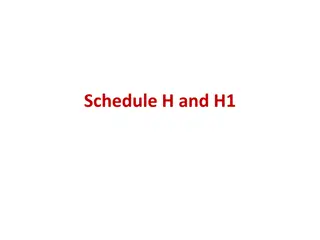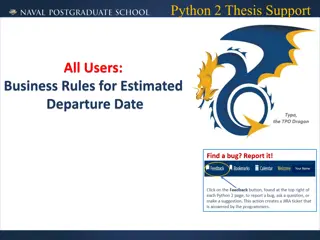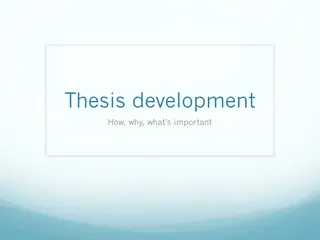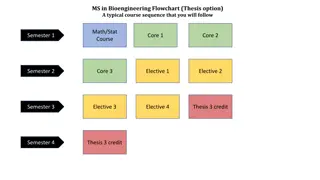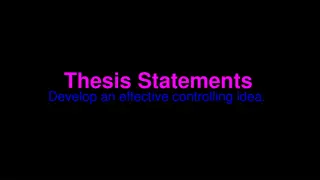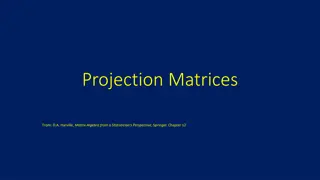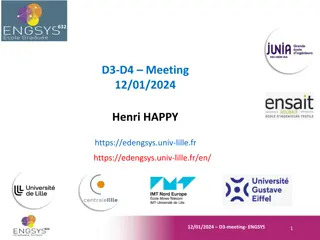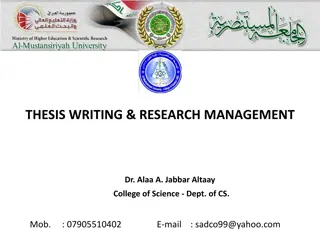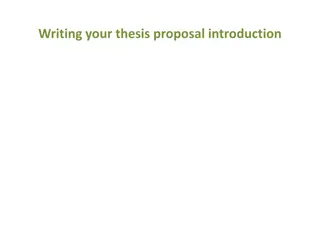
Thesis Research Fall 2022 Schedule & Project Details
Dive into the structured research journey of a thesis project for Fall 2022, covering chapters on introduction, location analysis, reference analysis, program details, and graduation design. Explore the purpose, goals, and impact of the project while unraveling site-specific challenges and architectural insights. Follow the chronological schedule for presentations and hardcopy submissions, unveiling a comprehensive exploration of architectural design challenges and solutions.
Download Presentation

Please find below an Image/Link to download the presentation.
The content on the website is provided AS IS for your information and personal use only. It may not be sold, licensed, or shared on other websites without obtaining consent from the author. If you encounter any issues during the download, it is possible that the publisher has removed the file from their server.
You are allowed to download the files provided on this website for personal or commercial use, subject to the condition that they are used lawfully. All files are the property of their respective owners.
The content on the website is provided AS IS for your information and personal use only. It may not be sold, licensed, or shared on other websites without obtaining consent from the author.
E N D
Presentation Transcript
THESIS RESEARCH FALL 2022
SCHEDULE Topic 18-10 Presentation go/no-go Chapter 1 introduction 02-11 Hardcopy & class work 10% & 5% Chapter 2 Location Analysis 16-11 Hardcopy & class work 10% & 5% Chapter 3 Reference Analysis 30-11 Hardcopy & class work 10% & 5% Chapter 4 Program 14-12 Hardcopy & class work 10% & 5% Chapter 5 DESIGN TBA Presentation 40%
CONTENT RESEARCH 1. CHAPTER ONE: INTRODUCTION 2. CHAPTER TWO: SIMILAR EXAMPLE 3. CHAPTER THREE: SITE 4. CHAPTER FOUR: PROGRAM 5. CHAPTER FIVE: GRADUATION DESIGN PROJECT
CHAPTER 1 1.1 Introduction to the chapter and project Start with a generic description about the purpose of this report and what the project is about. In this part also describe how the report is structured and mention the purpose of each chapter. 1.2 Define the project Define the project and describe the main functional typology and the nature of the project 1.3 Problem statement Describe which problem your project will aim to solve. These problems are architectural design challenges that needs to be solved.
CHAPTER 1 1.4 Scope of work Clarify the general approach of the project by describing the limitation of the project. 1.5 Project Goals Define the goals of the project. It is important that the goals are architectural. Defining the goals of the project will become a guideline for the design process.
CHAPTER 1 1.6 Impact and benefit Describe in what ways the project will impact the local society and built environment. Furthermore, it is also important if possible to describe the impact of the project from an overall perspective. Moreover, define what the benefits are of the project for the local society and built environment. 1.7 Historical Background This part is optional depending on the project.
CHAPTER 2 2.1 INTRODUCTION introduce this chapter: mention the structure and components of this chapter and its purpose introduce the similar example what was the reasons the for selecting these project mentioning for each/all similar example(s) which knowledge does the student want to gain from it (what do you want to learn from it) 2.2 Similar Example Analysis give general data about the project minimum data is: name of project, name of architect, location, when it is constructed, area) at the end student must give a conclusion, whereby they explain what the knowledge was they learned from it
CHAPTER 2 2.3 Program components Give table, whereby the student identify which components can be found in each similar example. Give a conclusion by explaining which components are the main components and which components has the student selected for their project. 2.4 Chapter summary Give a brief summary of chapter two
CHAPTER 3 3.1 INTRODUCTION Provide an overview of the chapter's content Introduce the 3 selected sites Explain the criteria that will be used to evaluate and select the most suitable site for the project.
CHAPTER 3 Criteria & Description: Location: Desired location for the project (e.g., city center, rural areas) Site Area: Required area for the project Parcel Shape: Recommended plot shape Site Topography: Preferred topography Accessibility: Preferred level of accessibility Socio-economic: Desired proximity to specific households Noise: Noise requirements View: Necessity or type of required view Sunlight Exposure: Sunlight exposure requirements Man-made Features: Need for proximity to specific man-made features/projects
CHAPTER 3 3.2 Site Evaluation Evaluate the 3 sites based on the criteria formulated from the requirements Create a weighted factors table to compare the sites Conclude by identifying the most suitable site
CHAPTER 3 3.3 Site Analysis of Selected Site Conduct the site analysis according to the instructions provided by the lecturer Follow the specified sequence, which includes the following components discussed during the lecture: Morphological analysis Building analysis Circulation Material Environment Historical survey and future planning Building regulations & international standards
CHAPTER 3 3.4 Conclusion Discuss the strengths and weaknesses of the selected site Provide possible solutions for addressing the identified weaknesses
CHAPTER 4 4.1 Introduction introduce the chapter Describing the main components and the capacity of the project 4.2 Components Give diagram of the components (identifying the programs for the project) Explaining the reasons for selecting these components based on goal, case studies, site analysis, standard
CHAPTER 4 4.3 Area calculation describe the calculation method based on standards or references Table for each component with regards to the necessary area (table based on the lecture given by Dr. Hussein) 4.4 Relation Scheme Give bubble diagram for the main components Give a matrix diagram for each (main) component Depending on the project, give a flow chart (beforehand discussed with the lecturer) 4.5 Summary


